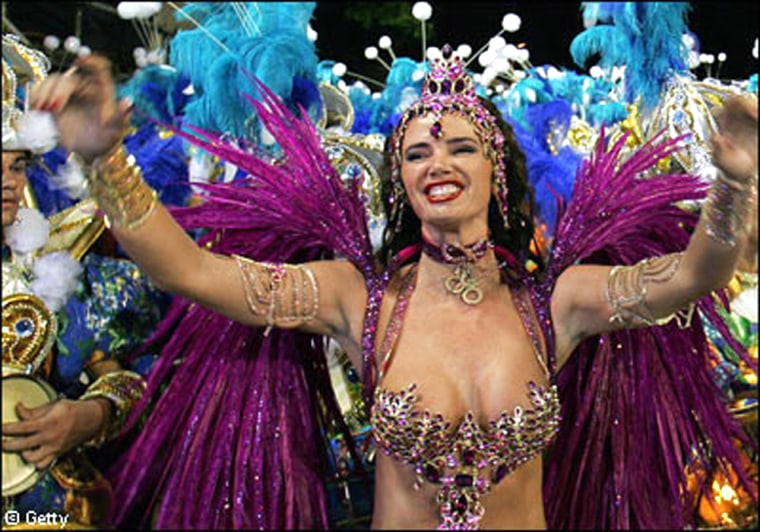Organized religion comes with its inconveniences: obligatory fasting; tithing; an overpopulation of cows. But there are major upsides, too--the promise of an afterlife, for one thing. And in the Christian tradition, a few fun weeks here on earth during Carnival.
In the American South, it's called Mardi Gras. In Switzerland, it's Fastnacht. And in Brazil, it's Carnaval. But these are all essentially the same holiday, which has its roots in a pagan tradition and has morphed from a religious event into a sometimes-tawdry commercial one (think Mardi Gras beads and Girls Gone Wild).
The idea is mass indulgence--orgiastic parades, feathered costumes, musical performances and food and drink--before the rigors of Lent set in. A period of deprivation and reflection, Lent begins on Ash Wednesday and ends with Easter. Carnival's exact dates change with the calendar year, and every city celebrates differently.
The Carnival of Binche, in Belgium, features drum parades and roaming Mam'selles (men dressed in elaborate feminine attire). Jamaica's Carnival was founded in 1989 by a reggae artist. The Venetians are famous for their Carnival masquerade balls and handmade ceramic and feather masks. (It was, in fact, in Italy that the term Carnival was coined: Catholics are forbidden from eating meat on Fridays during Lent, and in the 1200s, Italian peasants combined the Latin words for meat-- carne--and farewell-- vale.)
Some cities have built entire industries around these few weeks. In Rio de Janeiro, Samba musicians, costumed dancers with enormous plumed headdresses, parades and street vendors selling bolinos de bacalhau (deep-fried fish fritters) add up to a lot more than a whirlwind celebration. According to Hendersonville, Tenn.-based Smith Travel Research, Rio hotels reaped a total of $10.4 million in revenue in February 2005, a full 11% higher than in December, the year's next-most-profitable month, which brought in $9.4 million in gross revenue.
This year, all eyes are on another city, which historically draws much of its tourism dollars from Carnival: New Orleans, where Mardi Gras has been celebrated since 1699.
"Mardi Gras is the bedrock of New Orleans tourism, and its economic impact is equivalent to a Super Bowl, at over $300 million," says J. Stephen Perry, the president of the New Orleans Metropolitan Convention and Visitors Bureau. The Visitors Bureau maintains that, post-Hurricane Katrina, Mardi Gras is more than a cultural tradition--it is crucial to rebuilding the city, one tourist dollar at a time. This year, many of the "krewes," or local groups which put on the Mardi Gras parades, are donating to the city. The Krewe of Muses, for example, gave $50,000 to the New Orleans Police Department.
As hotels reopen and the city readies itself for what may be its most important Mardi Gras yet, local businesses have devised their own ways to measure the impact of tourism on the city. "Mardi Gras can bring up to a million visitors a year," claims Carol Blake, the owner of Mardigrasday.com, an online information source and product retailer for Mardi Gras. "We know how many came by the amount of trash left on the street." Over 20 tons means it was a good year, so residents and local business are hoping for lots of trash this year, which translates to lots of tourists.
Using Mardi Gras to line the city's coffers is hardly a new tactic, however. It was being done as far back as 1872, when Rex, the oldest Mardi Gras parade in New Orleans, was engineered to jump-start the city's economy, which was sluggish in the wake of Reconstruction.
With Lent 2006 approaching, Forbes.com decided to take a look at some of the biggest and best Carnival celebrations around the world. Our list includes 12 festivals, some better-known than others. We didn't put any age restrictions on our list: Some, like Jamaica's Carnival, were founded relatively recently, while others are almost a thousand years old. To qualify, the celebration simply had to be internationally recognized and fun.
Modern day Carnival celebrations have their roots in the Roman feast of Saturnalia, a winter festival to mark the commemoration of Saturn's temple. But it was during the Middle Ages in Europe that the festival came to resemble Carnival as we know it today. After all, for most of the population, life in 13th-century Italy or France was bleak: You spent it tilling land you didn't own to produce crops you'd never eat, while rarely bathing and doing your best to avoid the Plague. In the dead of winter, with the deprivations of Lent looming, a break was not just welcome, it was necessary.
Today, most of us don't till crops for a living, but a break from the winter is just as welcome. The list is not comprehensive, so if we've forgotten your favorite pre-Lenten bacchanal, please let us know. In the meantime, in the spirit of New Orleans, laissez les bon temps roulez!
